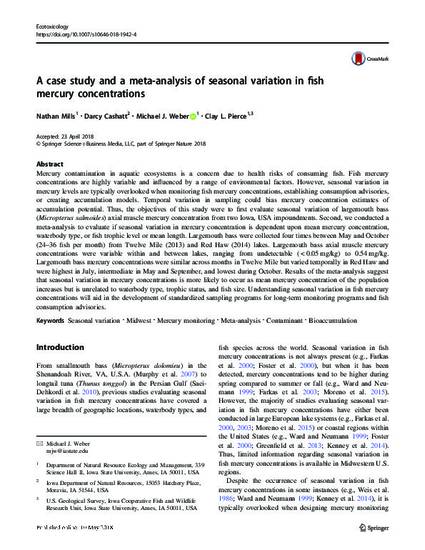
Mercury contamination in aquatic ecosystems is a concern due to health risks of consuming fish. Fish mercury concentrations are highly variable and influenced by a range of environmental factors. However, seasonal variation in mercury levels are typically overlooked when monitoring fish mercury concentrations, establishing consumption advisories, or creating accumulation models. Temporal variation in sampling could bias mercury concentration estimates of accumulation potential. Thus, the objectives of this study were to first evaluate seasonal variation of largemouth bass (Micropterus salmoides) axial muscle mercury concentration from two Iowa, USA impoundments. Second, we conducted a meta-analysis to evaluate if seasonal variation in mercury concentration is dependent upon mean mercury concentration, waterbody type, or fish trophic level or mean length. Largemouth bass were collected four times between May and October (24–36 fish per month) from Twelve Mile (2013) and Red Haw (2014) lakes. Largemouth bass axial muscle mercury concentrations were variable within and between lakes, ranging from undetectable ( < 0.05 mg/kg) to 0.54 mg/kg. Largemouth bass mercury concentrations were similar across months in Twelve Mile but varied temporally in Red Haw and were highest in July, intermediate in May and September, and lowest during October. Results of the meta-analysis suggest that seasonal variation in mercury concentrations is more likely to occur as mean mercury concentration of the population increases but is unrelated to waterbody type, trophic status, and fish size. Understanding seasonal variation in fish mercury concentrations will aid in the development of standardized sampling programs for long-term monitoring programs and fish consumption advisories.
Available at: http://works.bepress.com/michael_weber/21/

This article is published as Mills, Nathan, Darcy Cashatt, Michael J. Weber, and Clay L. Pierce. "A case study and a meta-analysis of seasonal variation in fish mercury concentrations." Ecotoxicology (2018): 1-9. DOI: 10.1007/s10646-018-1942-4. Posted with permission